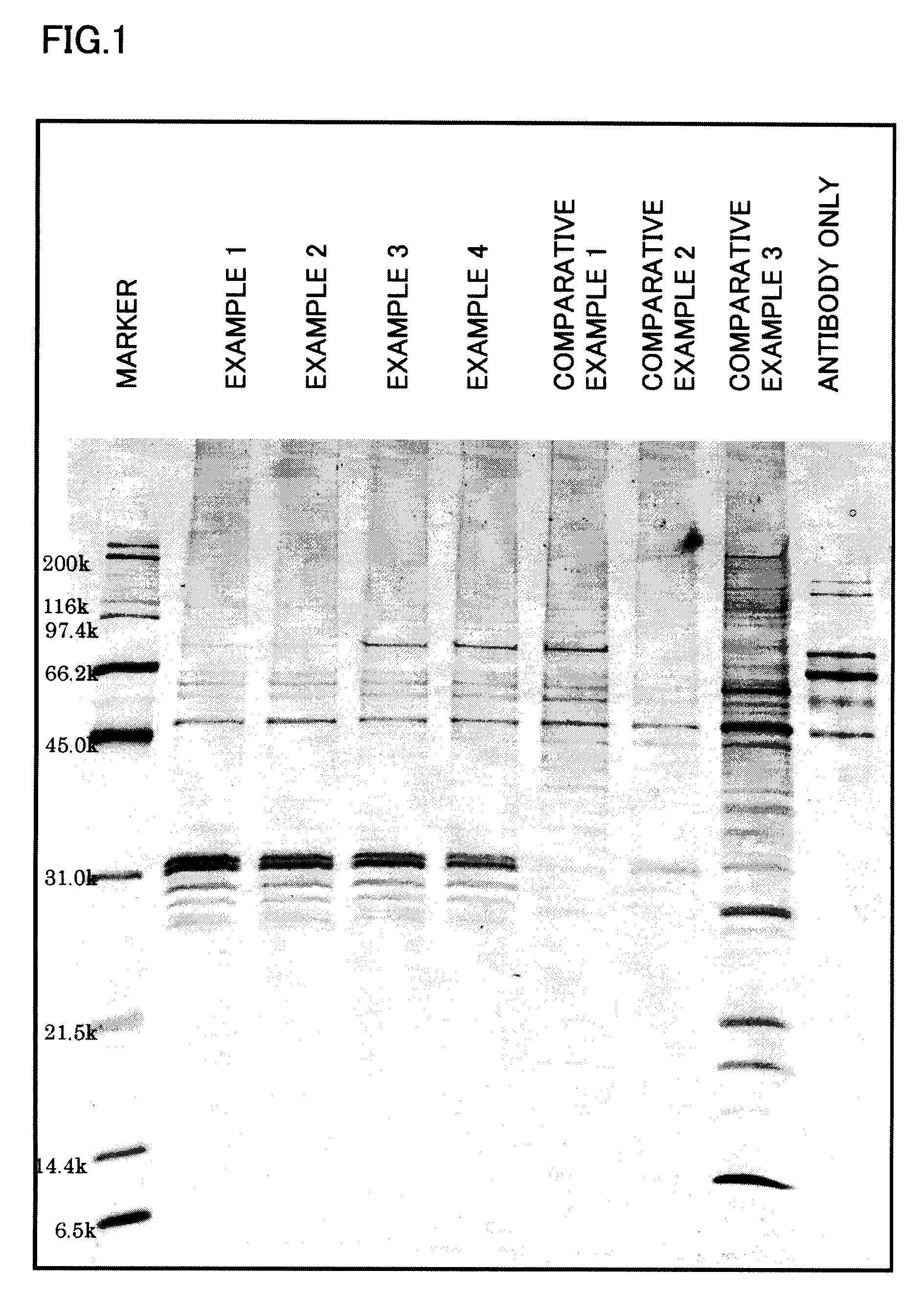Magnetic particles, method for producing same, and probe-bonded particles
a technology of magnetized particles and probes, which is applied in the field of magnetized particles, a method for producing the same, and probed-bonded particles, which can solve the problems of reducing the activity of bonded probes, non-specific adsorption being a serious hindrance, and hindering the performance of sensitization particles
- Summary
- Abstract
- Description
- Claims
- Application Information
AI Technical Summary
Benefits of technology
Problems solved by technology
Method used
Image
Examples
example 1
3.3. Example 1
Preparation of Amino Group-Introduced Magnetic Particles for Probe Bonding and Evaluation of Probe-Bonded Magnetic Particles
[0133]The particles obtained from the magnetic particles A-3 with a second polymer layer having glycidyl groups formed thereon by magnetic separation were dispersed in acetone. After repeating a procedure of separating the particles by magnetism and washing the separated particles with acetone five times, the particles were again dispersed in acetone and the supernatant liquid was removed by magnetic separation. The particles obtained were dried. 0.50 g of the particles were put into a 100 ml flask and 25 g of ethylenediamine was added. The particles were dispersed by indirect ultrasonic radiation for 20 minutes. The dispersion liquid was stirred at 50° C. in a nitrogen atmosphere for 3 hours (introduction of amino groups).
[0134]After cooling, the particles were separated by magnetic separation and dispersed in distilled water. A procedure of magn...
example 2
3.4. Example 2
Preparation of Aldehyde Group-Introduced Magnetic Particles for Probe Bonding and Evaluation of Probe-Bonded Magnetic Particles
[0138]5 g of a 1% aqueous solution of sulfuric acid was added to 0.5 g of particles separated by magnetic separation from a water dispersion of magnetic particles A-3 with a second polymer layer having glycidyl groups formed thereon. The particles were dispersed by indirect ultrasonic radiation for 20 minutes and the dispersion liquid was stirred at 60° C. for 5 hours (hydrolysis of glycidyl groups).
[0139]The particles were separated by magnetic separation and dispersed in purified water. A procedure of magnetic separation and washing was repeated five times. 20 ml of a 5.6 mg / ml aqueous solution of sodium periodate was added to the particles obtained by magnetic separation and the mixture was reacted at room temperature for one hour while stirring (introduction of aldehyde groups).
[0140]The particles were separated by magnetic separation and t...
example 3
3.5. Example 3
Preparation of Carboxyl Group-Introduced Magnetic Particles for Probe Bonding and Evaluation of Probe-Bonded Magnetic Particles
[0143]10 g of a 1% aqueous solution of sulfuric acid was added to 1.0 g of particles separated from a water dispersion of magnetic particles A-3 with a second polymer layer having glycidyl groups formed thereon by magnetic separation. The particles were dispersed by indirect ultrasonic radiation for 20 minutes and the dispersion liquid was stirred at 60° C. for five hours (hydrolysis of glycidyl groups).
[0144]The particles were separated by magnetic separation, dispersed in purified water. A procedure of dispersing in purified water, separating by magnetism, and washing was repeated five times. The particles were dried. 1.0 g of the resulting dry particles was washed with 10 ml of pyridine, dispersed in 5 ml of pyridine, added to a solution of 3 g of succinic acid anhydride dissolved in 25 ml of pyridine. The mixture was stirred at 60° C. for t...
PUM
| Property | Measurement | Unit |
|---|---|---|
| diameter | aaaaa | aaaaa |
| particle diameter | aaaaa | aaaaa |
| particle diameter | aaaaa | aaaaa |
Abstract
Description
Claims
Application Information
 Login to View More
Login to View More - R&D
- Intellectual Property
- Life Sciences
- Materials
- Tech Scout
- Unparalleled Data Quality
- Higher Quality Content
- 60% Fewer Hallucinations
Browse by: Latest US Patents, China's latest patents, Technical Efficacy Thesaurus, Application Domain, Technology Topic, Popular Technical Reports.
© 2025 PatSnap. All rights reserved.Legal|Privacy policy|Modern Slavery Act Transparency Statement|Sitemap|About US| Contact US: help@patsnap.com


